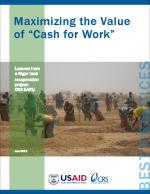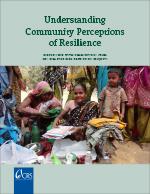About Food Security and Livelihoods
WHAT WE DO
Emergencies can cause extreme hardship. There is often destruction of homes and infrastructure, like roads and bridges, plus a breakdown in normal economic processes. As a result, people in disaster-stricken areas often lack access to food or are unable to earn money to buy food. CRS organizes cash-for-work initiatives that put people back to work as quickly as possible after a crisis.
Short-term programming objectives
These programs provide food for those who are highly food insecure. In most cases, these programs target victims of man-made emergencies (i.e. war) and natural disasters (i.e. hurricanes, earthquakes) in addition to vulnerable populations.
Short-term food security programs are usually one of two types: emergency programs, which provide food aid and medical and agricultural supplies to victims and refugees; and safety net programs, which distribute basic food and food supplements to vulnerable populations, like children, the elderly and the mentally ill.
Medium-term programming objectives
Medium-term programs focus on consumption needs and investments in food security and more closely fit into the traditional food security components of availability, access and utilization. Programs focus on three main sectors:
In the agricultural sector, CRS' programs aim to improve household food availability by increasing staple food and livestock production, nurturing home gardening, improving storage facilities and investing in agricultural infrastructure.
In income generation, programs aim to improve household access to food by increasing non-farm income and savings. To achieve this objective, interventions include microfinance programs and increased cash crop production.
Health sector projects aim to improve the individual's ability to utilize food. Health programs typically revolve around four main areas: child survival, maternal and child health, improved sanitation infrastructure and HIV and AIDS education.
Long-term programming objectives
Long-term programs focus on building a foundation for sustainable food security. These programs seek to change the conditions under which long-term hunger and poverty develop and persist. Programs focus on areas such as education, natural resource management and peacebuilding.
-
In education, we seek to develop human capital by providing literacy and math skills for adults, encouraging school enrollment and attendance among children, especially girls, and by improving educational infrastructure.
-
In natural resource management, CRS promotes agricultural sustainability through projects in soil and water conservation, reforestation, and improved agricultural practices.
-
In peacebuilding, CRS promotes justice through peace and reconciliation programming.
HOW WE DO IT
-
Focused & Long-Reaching: The objectives of CRS’ food security programming are twofold: to alleviate immediate hunger through increased consumption and to encourage sustainable food security by changing the conditions under which hunger develops and persists.
-
Empowered: CRS looks beyond addressing immediate needs with food, water and shelter. Our response to an emergency often includes paying residents in cash or food in exchange for help with reconstruction. The work that community members do can help mitigate the effects of the next disaster—whether it be war, food shortages or severe weather. Cash-for-work supports local employment and income.
-
Integrated: We integrate our food security and livelihoods programming with our activities to restore shelters and settlements, improve water and sanitation, protect highly vulnerable populations, and help communities become more resilient to future disasters.
Research & Publications
-
Best Practices
Maximizing the Value of Cash for Work
Lessons from a Niger land recuperation project, CRS EARLI

This report describes the 20 best practices distilled from a recent Real Time Evaluation of EARLI, a cash for work program implemented by CRS in Niger. More
-
Evaluations/Assessments
Understanding Community Perceptions of Resilience
Discussions with Communities from CRS Disaster Risk Reduction Projects

This study offers recommendations and lessons learned about what types of programs are most effective in promoting resilience. More

